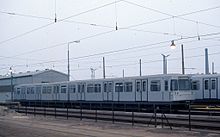Metro Vienna U
| Vienna underground railcar U |
|
|---|---|
|
Railcar in the Leopoldau depot on the U1
|
|
| Numbering: | 2001–2136 (converted to type U2 from 2063) |
| Number: | 136 (73 converted to Type U2) |
| Manufacturer: | Simmering-Graz-Pauker factory in Simmering |
| Year of construction (s): | 1972-1982 |
| Retirement: | 2011-2018 (car retired in 2017 2006) |
| Gauge : | 1,435 mm ( standard gauge ) |
| Length: | 36.8 m |
| Width: | 2.8 m |
| Empty mass: | 52.6 t |
| Top speed: | 80 km / h |
| Continuous output : | 4 × 200 kW |
| Power system : | 750 V = |
| Power transmission: | Lateral power rail coated from below |
| Control: | manual, semi-automatic |
| Seats: | 98 |
| Standing room: | 182 |
The Type U , also known as the “Silver Arrow”, describes the first generation of Vienna's subway vehicles. These were produced by SGP from 1972 and formed the backbone of the vehicle fleet of the Vienna subway network. They ran in the entire subway network with busbars , except on the U6 line , which is operated with overhead lines. On the U4 line , they replaced the two-axle N 1 / n 2 trains of the Vienna Electric City Railroad . A distinction is made between type U, type U 1 and type U 2 .
technology
The concept of the vehicles is very much based on row A of the Munich subway or the DT1 row of the Nuremberg subway . The sets are double multiple units , i.e. two electric multiple units firmly coupled with one another, each with a driver's cab at each end. The smallest operational unit consists of a double multiple unit, but a short train consists of two and a long train consists of three double multiple units. However, the short train concept was abandoned as the number of passengers increased, so that there are now six-car trains (three double multiple units) in the Vienna network. The two vehicles of a double unit are not equipped identically. Assemblies such as the rear derailleur, compressor, battery, converter and others have been divided between the two cars for reasons of weight distribution. Because of the narrow clearance profile , these units are mounted under the vehicle floor. The difference can be seen from the outside of the car number - a 2000 and a 3000 car form a double unit. Due to the part of the circle driven on the original U2 route, there was one-sided wear, which was counteracted by periodically turning the sets. For this purpose, Europe's largest turntable for a double unit was put into operation in 1988 at the Wasserleitungswiese station with a diameter of 40 m .
Each bogie has a longitudinally installed DC drive motor, and the side pantographs are also attached to them. The car body is made of aluminum to reduce weight .
Further development
In 1987 a further developed generation of vehicles was presented, the type U 1 or U 11 , which outwardly are almost identical to the original vehicles. In addition to completely newly developed bogies, they also have a three-phase drive, which corresponds to the state of the art at the time, including the necessary power electronics , which also enabled the use of a recuperation brake .
In the years 2000–2010, 74 type U double railcars were converted to three-phase drive with frequency converters built into the vehicle, in order to be operational for a further 20 years. These vehicles are referred to as Type U 2 .
The next generation is the Type V , which was produced from 2000. From 2020, the type U trains are to be gradually replaced by the new type X from Siemens.
After the last passenger transport operations in the school year 2014/15, which only happened occasionally, the last U were used in their original state in the driving school. When the driving simulator went into operation at the beginning of 2016, they were no longer needed and were taken out of service.
Color scheme and design
The designer Johann Benda was responsible for the design of the vehicle at SGP . The exterior of the vehicles is completely silver-gray, which has earned the vehicle the nickname Silver Arrows with the continuous light strips on the front . The interior walls are kept in orange in keeping with the spirit of the 1970s.
The design was awarded the "State Prize for Good Form 1981" by the Ministry of Commerce.
literature
- Author collective: 3 decades of underground construction in Vienna . Heinz Keller Druck und Verlag OHG, Vienna 2000, ISBN 3-900607-39-7 .
- Stefan Göbel, Dierk Lowrenz, Ernst-Andreas Weigert: 1000 rail vehicles , Naumann & Göbel Verlagsgesellschaft, Cologne, ISBN 978-3-625-12225-8
Web links
Individual evidence
- ↑ Award for subway design: A state award for the "Silver Arrows" . In: Arbeiter-Zeitung . Vienna October 20, 1981, p. 10 ( berufer-zeitung.at - the open online archive - digitized).



